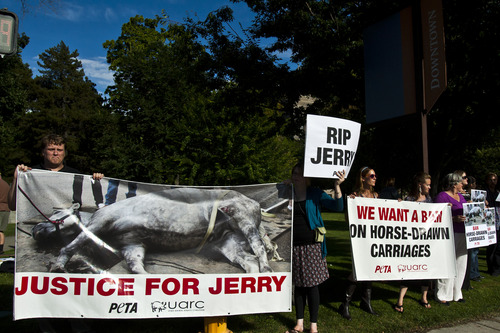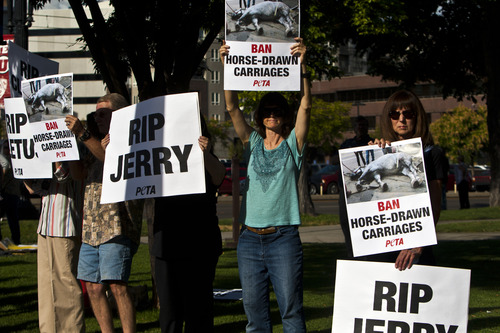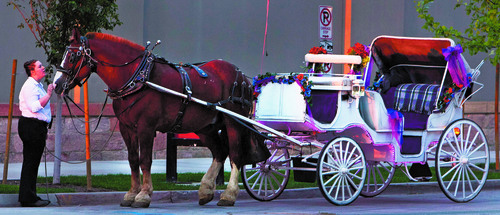This is an archived article that was published on sltrib.com in 2013, and information in the article may be outdated. It is provided only for personal research purposes and may not be reprinted.
Hold your horses. The Salt Lake City Council will not ban carriages downtown.
But whether it will change the way horse-drawn carriages are regulated is as clear as mud.
The conundrum surrounding the Aug. 17 collapse of Jerry the horse on a downtown street and his ultimate death took the council on a dizzying 90-minute discussion Tuesday afternoon that seemed to consider everything but hay and horseshoes.
In the end, the council voted to ask Mayor Ralph Becker and Salt Lake County Animal Services – which contracts with the city to regulate all animal-related issues – to help craft an ordinance for regulating horse-drawn carriages.
"We punted," said Councilman Luke Garrott of the council's decision to defer taking action. He was the lone vote for a ban of horse-drawn carriages.
The council discussed whether it should change the way horse carriages are regulated from a permit system to a contract system – similar to what it is about to do with taxicabs.
Council members also discussed a report from its staff that looked at horse carriage regulations in 19 other U.S. cities. That report included a "best practices" section that outlined items including weight-pulling limits, maximum work hours, mandatory breaks and weather conditions including temperature.
The council will take up the matter at a yet to be determined future date, depending on the information provided by Salt Lake County, Becker and other organizations that regulate animals.
Councilman Charlie Luke attempted to seek a compromise that would not have banned carriages but would have tightened regulations to, among other things, limit horses to one 8-hour shift per day with 10 minute breaks each hour. It would have prevented horses from working in inclement weather that includes thunderstorms and icy roads, and it would disallow operations below 26 degrees and above 90.
Luke's plan would have limited carriages to a single route: from 300 North and 300 West it would go east to West Temple, where it would go south to North Temple and then proceed east to Canyonside Road and north to Memory Grove. Carriages would then retrace the route back to the Carriage for Hire barn.
"It creates predictability," Luke said. "Pedestrians, bicyclists and motorists would all know where to expect to see them."
A majority of the council would not sign on to Luke's plan. However, he may introduce it at a later date.
Council members Soren Simonsen and Jill Remington Love said that although Jerry's death was tragic, the council should be careful not to overreact.
"There were a lot of portrayals of inhumane treatment of this animal that weren't true," Simonsen said. "This horse died of a disease, not something else."
And he added that the number of incidents involving carriages "pales when compared with incidents involving cars."
According to Salt Lake City police statistics, there have been nine incidents involving horses since August 2009, including the one in which Jerry the horse died.
In an interview, Jeremy Beckham, a spokesman for People for the Ethical Treatment of Animals, chided the council for its inaction.
"The upshot is, they are passing the buck," he said. "I don't think it's appropriate for Salt Lake County Animal Services to weigh in on a Salt Lake City policy issue."
The council may have delayed the issue, but it is not over, Beckham said.
"This controversy will continue. What the City Council did today will make people angry," he said. "People in Salt Lake City really care about this issue.







